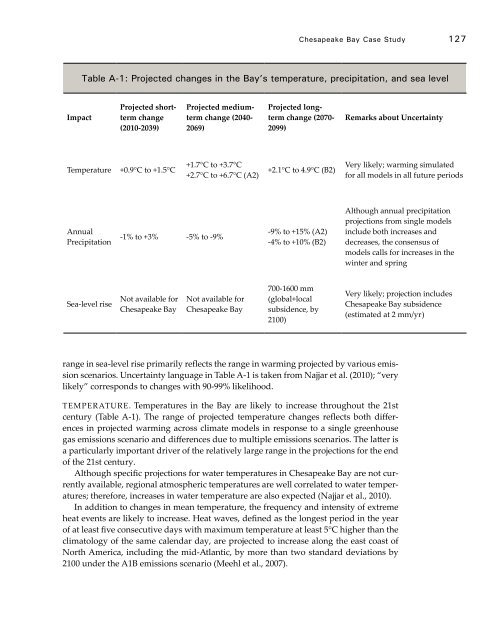Coastal Impacts, Adaptation, and Vulnerabilities - Climate ...
Coastal Impacts, Adaptation, and Vulnerabilities - Climate ...
Coastal Impacts, Adaptation, and Vulnerabilities - Climate ...
Create successful ePaper yourself
Turn your PDF publications into a flip-book with our unique Google optimized e-Paper software.
Chesapeake Bay Case Study 127Table A-1: Projected changes in the Bay’s temperature, precipitation, <strong>and</strong> sea levelImpactProjected shorttermchange(2010-2039)Projected mediumtermchange (2040-2069)Projected longtermchange (2070-2099)Remarks about UncertaintyTemperature +0.9°C to +1.5°C+1.7°C to +3.7°C+2.7°C to +6.7°C (A2)+2.1°C to 4.9°C (B2)Very likely; warming simulatedfor all models in all future periodsAnnualPrecipitation -1% to +3% -5% to -9% -9% to +15% (A2)-4% to +10% (B2)Although annual precipitationprojections from single modelsinclude both increases <strong>and</strong>decreases, the consensus ofmodels calls for increases in thewinter <strong>and</strong> springSea-level riseNot available forChesapeake BayNot available forChesapeake Bay700-1600 mm(global+localsubsidence, by2100)Very likely; projection includesChesapeake Bay subsidence(estimated at 2 mm/yr)range in sea-level rise primarily reflects the range in warming projected by various emissionscenarios. Uncertainty language in Table A-1 is taken from Najjar et al. (2010); “verylikely” corresponds to changes with 90-99% likelihood.Temperature. Temperatures in the Bay are likely to increase throughout the 21stcentury (Table A-1). The range of projected temperature changes reflects both differencesin projected warming across climate models in response to a single greenhousegas emissions scenario <strong>and</strong> differences due to multiple emissions scenarios. The latter isa particularly important driver of the relatively large range in the projections for the endof the 21st century.Although specific projections for water temperatures in Chesapeake Bay are not currentlyavailable, regional atmospheric temperatures are well correlated to water temperatures;therefore, increases in water temperature are also expected (Najjar et al., 2010).In addition to changes in mean temperature, the frequency <strong>and</strong> intensity of extremeheat events are likely to increase. Heat waves, defined as the longest period in the yearof at least five consecutive days with maximum temperature at least 5°C higher than theclimatology of the same calendar day, are projected to increase along the east coast ofNorth America, including the mid-Atlantic, by more than two st<strong>and</strong>ard deviations by2100 under the A1B emissions scenario (Meehl et al., 2007).
















